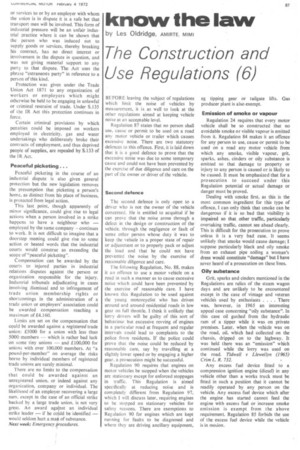know the law
Page 91

If you've noticed an error in this article please click here to report it so we can fix it.
by Les Oldridge, AMIRTE, MIMI
The Construction and Use Regulations (6)
BEFORE leaving the subject of regulations which limit the noise of vehicles by measurement, it is as well to look at the other regulations aimed at keeping vehicle noise at an acceptable level.
Regulation 87 states that no person shall use, cause or permit to be used on a road any motor vehicle or trailer which causes excessive noise. There are two statutory defences to this offence. First, it is laid down that it is a good defence to prove that the excessive noise was due to some temporary cause and could not have been prevented by the exercise of due diligence and care on the part of the owner or driver of the vehicle.
Second defence
The second defence is only open to a driver who is not the owner of the vehicle concerned. He is entitled to acquittal if he can prove that the noise arose through a defect in the design or construction of the vehicle, through the negligence or fault of some other person whose duty it was to keep the vehicle in a proper state of repair or adjustment or to properly pack or adjust the load and that he could not have prevented the noise by the exercise of reasonable diligence and care.
The following Regulation, No. 88, makes it an offence to use a motor vehicle on a road in such a manner as to cause excessive noise which could have been prevented by the exercise of reasonable care. I have known this Regulation to be used against the young motorcyclist who has driven around and around residential roads in low gear on full throttle. I think it unlikely that lorry drivers will be guilty of this sort of behaviour but excessive revving of engines in a particular road at frequent and regular intervals could lead to complaints to the police from residents. If the police could prove that the noise could be reduced by reasonable care, say by travelling at a slightly lower speed or by engaging a higher gear, a prosecution might be successful.
Regulation 90 requires that engines on motor vehicles be stopped when the vehicles are stationary except for enforced stoppages in traffic. This Regulation is aimed specifically at reducing noise and is completely different from Regulation 97, which I will discuss later, requiring engines to be stopped on stationary vehicles for safety reasons. There are exemptions to Regulation 90 for engines which are kept running for faults to be diagnosed and where they are driving ancillary equipment, eg tipping gear or tailgate lifts. Gas producer plant is also exempt.
Emission of smoke or vapour
Regulation 24 requires that every motor vehicle shall be so constructed that no avoidable smoke or visible vapour is emitted from it. Regulation 84 makes it an offence for any person to use, cause or permit to be used on a road any motor vehicle from which any smoke, visible vapour, grit, sparks, ashes, cinders or oily substance is emitted so that damage to property or injury to any person is caused or is likely to be caused. It must be emphasized that for a prosecution to succeed under this Regulation potential or actual damage or danger must be proved.
Dealing with smoke first, as this is the most common ingredient for this type of offence, I can only think that smoke can be dangerous if it is so. bad that visibility is impaired so that other traffic, particularly overtaking traffic, cannot see ahead clearly. This is difficult for the prosecution to prove unless it is a very bad case. It seems unlikely that smoke would cause damage; I suppose particularly black and oily smoke from an exhaust pipe soiling a woman's dress would constitute "damage" but I have never heard of a prosecution on these lines.
Oily substance
Grit, sparks and cinders mentioned in the Regulations are relics of the steam wagon days and are unlikely to be encountered except in the case of vintage and veteran vehicles used by enthusiasts . . . . There was, however, in 1965 an interesting appeal case concerning "oily substance". In this case oil gushed from the hydraulic ram of a tipper while it was on private premises. Later, when the vehicle was on the road, oil, which had collected on the chassis, dripped on to the highway. It was held there was an "emission" which continued while the lorry, was used on the road. Tidwell v Llewellyn (1965) Crim L. R. 732.
Any excess fuel device fitted to a compression ignition engine (diesel) in any vehicle other than a works truck must be fitted in such a position that it cannot be readily operated by any person on the vehicle. Any excess fuel device which after the engine has started cannot feed the engine with excess fuel or increase smoke emission is exempt from the above requirement. Regulation 85 forbids the use of the excess fuel device while the vehicle is in motion.














































































































































